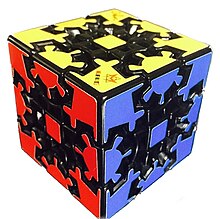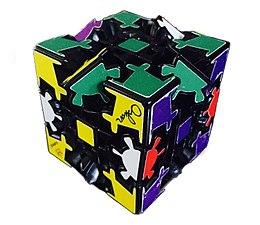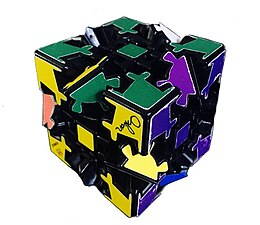
The Rubik's Cube is a 3D combination puzzle invented in 1974 by Hungarian sculptor and professor of architecture Ernő Rubik. Originally called the Magic Cube, the puzzle was licensed by Rubik to be sold by Pentangle Puzzles in the UK in 1978, and then by Ideal Toy Corp in 1980 via businessman Tibor Laczi and Seven Towns founder Tom Kremer. The cube was released internationally in 1980 and became one of the most recognized icons in popular culture. It won the 1980 German Game of the Year special award for Best Puzzle. As of January 2024, around 500 million cubes had been sold worldwide, making it the world's bestselling puzzle game and bestselling toy. The Rubik's Cube was inducted into the US National Toy Hall of Fame in 2014.

The Rubik's Revenge is a 4×4×4 version of the Rubik's Cube. It was released in 1981. Invented by Péter Sebestény, the cube was nearly called the Sebestény Cube until a somewhat last-minute decision changed the puzzle's name to attract fans of the original Rubik's Cube. Unlike the original puzzle, it has no fixed faces: the center faces are free to move to different positions.

Optimal solutions for the Rubik's Cube are solutions that are the shortest in some sense. There are two common ways to measure the length of a solution. The first is to count the number of quarter turns. The second is to count the number of outer-layer twists, called "face turns". A move to turn an outer layer two quarter (90°) turns in the same direction would be counted as two moves in the quarter turn metric (QTM), but as one turn in the face metric.
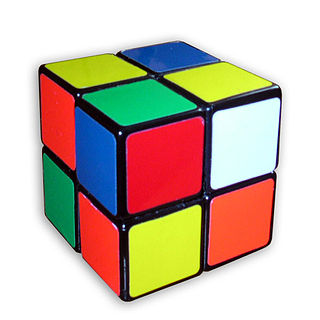
The Pocket Cube is a 2×2×2 combination puzzle invented in 1970 by American puzzle designer Larry D. Nichols. The cube consists of 8 pieces, all corners.
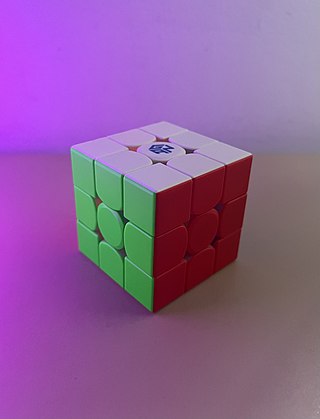
Speedcubing, also referred to as speedsolving, is a competitive sport centered around the rapid solving of various combination puzzles. The most prominent puzzle in this category is the 3x3x3 puzzle, commonly known as the Rubik's Cube. Participants in this sport are known as "speedcubers," who focus specifically on solving these puzzles at high speeds, or more generally as "cubers". The essential aspect of solving these puzzles typically involves executing a series of predefined algorithms in a particular sequence.

The Professor's Cube is a 5×5×5 version of the original Rubik's Cube. It has qualities in common with both the 3×3×3 Rubik's Cube and the 4×4×4 Rubik's Revenge, and solution strategies for both can be applied.
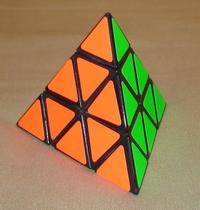
The Pyraminx is a regular tetrahedron puzzle in the style of Rubik's Cube. It was made and patented by Uwe Mèffert after the original 3 layered Rubik's Cube by Ernő Rubik, and introduced by Tomy Toys of Japan in 1981.

The Rubik's Clock is a mechanical puzzle invented and patented by Christopher C. Wiggs and Christopher J. Taylor. The Hungarian sculptor and professor of architecture Ernő Rubik bought the patent from them to market the product under his name. It was first marketed in 1988.

The Square-1 is a variant of the Rubik's Cube. Its distinguishing feature among the numerous Rubik's Cube variants is that it can change shape as it is twisted, due to the way it is cut, thus adding an extra level of challenge and difficulty. The Super Square One and Square Two puzzles have also been introduced. The Super Square One has two additional layers that can be scrambled and solved independently of the rest of the puzzle, and the Square Two has extra cuts made to the top and bottom layer, making the edge and corner wedges the same size.
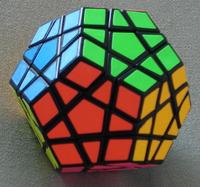
The Megaminx or Mégaminx is a dodecahedron-shaped puzzle similar to the Rubik's Cube. It has a total of 50 movable pieces to rearrange, compared to the 20 movable pieces of the Rubik's Cube.

The Dogic is an icosahedron-shaped puzzle like the Rubik's Cube. The 5 triangles meeting at its tips may be rotated, or 5 entire faces around the tip may be rotated. It has a total of 80 movable pieces to rearrange, compared to the 20 pieces in the Rubik's Cube.

The Skewb is a combination puzzle and a mechanical puzzle in the style of the Rubik's Cube. It was invented by Tony Durham and marketed by Uwe Mèffert. Although it is cubical, it differs from the typical cubes' construction; its axes of rotation pass through the corners of the cube, rather than the centers of the faces. There are four axes, one for each space diagonal of the cube. As a result, it is a deep-cut puzzle in which each twist affects all six faces.
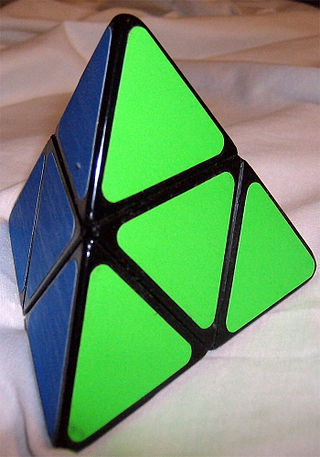
The Pyramorphix, also called Pyramorphinx, is a tetrahedral puzzle similar to the Rubik's Cube. It has a total of 8 movable pieces to rearrange, compared to the 20 of the Rubik's Cube. Although it looks like a trivially simple version of the Pyraminx, it is an edge-turning puzzle with the mechanism identical to that of the Pocket Cube.

The Pyraminx Crystal is a dodecahedral puzzle similar to the Rubik's Cube and the Megaminx. It is manufactured by Uwe Mèffert and has been sold in his puzzle shop since 2008.

The Void Cube is a 3-D mechanical puzzle similar to a Rubik's Cube, with the notable difference being that the center pieces are missing, which causes the puzzle to resemble a level 1 Menger sponge. The core used on the Rubik's Cube is also absent, creating holes straight through the cube on all three axes. Due to the restricted volume of the puzzle it employs an entirely different structural mechanism from a regular Rubik's Cube, though the possible moves are the same. The Void Cube was invented by Katsuhiko Okamoto. Gentosha Education, in Japan, holds the license to manufacture official Void Cubes. These official designs are also sold under the Rubik's brand, owned by Spin Master Ltd., and workalikes are available from a variety of manufacturers. Speed-solving the Void Cube is common in exhibition but is not an official World Cube Association competition event.
The Rubik's Triamid is a mechanical puzzle invented by Ernő Rubik and released in 1990 by Matchbox. The puzzle was patented in Hungary in 1991. It was re-released in 2017 at the American International Toy Fair by Winning Moves.

Oskar van Deventer is a Dutch puzzle maker. He prototypes puzzles using 3D printing. His work combines mathematics, physics, and design, and he collaborates at academic institutions. Many of his combination puzzles are in mass production by Uwe Mèffert and WitEden. Oskar van Deventer has also designed puzzles for Hanayama.

The Pyraminx Duo is a tetrahedral twisty puzzle in the style of the Rubik's Cube. It was suggested by Rob Stegmann, invented by Oskar van Deventer, and has now been mass-produced by Meffert's.

The Nine-Colour Cube is a cubic twisty puzzle. It was invented in 2005 by Milan Vodicka and mass-produced by Meffert's seven years later. Mechanically, the puzzle is identical to the Rubik's Cube; however, unlike the 3×3×3 Rubik's Cube, which only has 6 different colours, the Nine-Colour Cube has 9 colours, with the individual pieces having one colour each.

The Dino Cube is a cubic twisty puzzle in the style of the Rubik's Cube. It was invented in 1985 by Robert Webb, though it was not mass-produced until ten years later. It has a total of 12 external movable pieces to rearrange, compared to 20 movable pieces on the Rubik's Cube.
